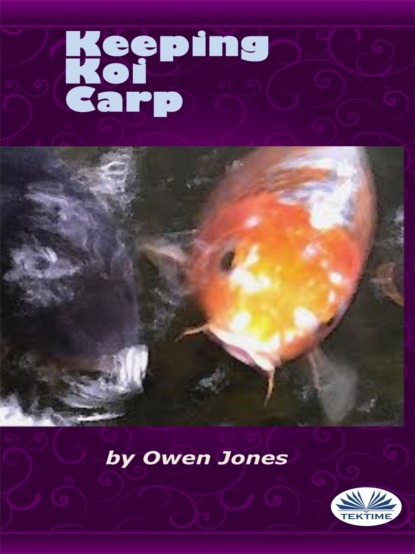По всем вопросам обращайтесь на: info@litportal.ru
(©) 2003-2024.
✖
Keeping Koi Carp
Настройки чтения
Размер шрифта
Высота строк
Поля
Once you have the best site, you have to think about size and shape. The most popular shapes are: round, square, oval and kidney shaped. The depth of the water is also significant if you live in an area that is subject to freezing. Thirty to forty-five inches is enough in most instances, but it would be worth asking neighbours or the local pet shop for guidance.
Once your pond is in place, you can set up your equipment. You will have to have a pump to suck the debris out of the water and forward it to the pond filter. However, this pump will let plant debris to pass through it, so if you would like a fountain, you will almost certainly need another pump, otherwise the fountain's jets will become blocked by rotting vegetation.
If this all seems a bit much, you can buy a pond kit which contains all the bits and pieces you will require to set up a backyard fish pond. One tip here,: if you get solar-powered equipment, it will save on electrician's fees and you will never have an electricity bill for your backyard fish pond.
After fitting the pumps, filter and fountain, you can fill the pond up with water and turn the devices on. The water is inappropriate for fish at the moment, so just allow the apparatus run in and the water mature. This will take a week for the water. Meanwhile, choose your fish and plants and make any hidey-holes you want to put in for your fish.
When the week is up, you can add your plants and populate your backyard fish pond with fish.
1 Caring for Your Fish Pond during the Summer
The summer is the best time of the year to be seated in the garden with your favourite ice-cold drink and gaze at your fish and the rest of your garden. It is the busiest time of the year for both your pond and your garden flowers and the birds and the bees are at their most active as well.
If you would like to keep on enjoying your garden and pond into the evening, you can arrange external lighting at strategic points to highlight the best locations. However, in spite of wanting to just relax in the warmth, there are still some chores that you will have to do to care for your fish pond during the summer.
The first thing you have to do is ensure that you fish are getting enough oxygen. The problem is that warm water contains less oxygen that cold water, so you have to take extra precautions in the summer. This is fairly easily corrected by mechanical, automatic methods. There are three basic methods of oxygenating fish pond water.
The most important technique is the use of a fish pond filter. Endeavour to have the water pumped several feet above the pond water level. The water is then passed through the filter and it should fall down a few steps back into the water. Every time the water falls, it will pick up more oxygen, which it will return to the pond.
The second way is also the most impressive - the fountain. Most fountains have a couple of settings to permit various water patterns. All the patterns will aerate the water. A high, single jet of water will make the most noise when it returns the pond, while a pattern of say, ten less-powerful sprays will hardly make any noise at all.
The third method of aerating the pond water is the 'bubbler'. This device sucks air from above the waterline and releases it below the water line - it is the type of oxygenation device that indoor fish tanks utilize, but on a larger scale.
The use of these three methods in the summer will make certain that your fish always have enough oxygen no matter how hot it gets.
The next matter is feeding. Fishes' metabolism increases during the summer. They also have to build up fat, because they will not eat much during the winter. You can ensure that your fish get plenty of insects to eat by fitting a light by the water side. You can either take a feed off the pond pump or you could place a solar powered light there in stead.
The insects will be attracted to the light and fall into the water. The fish will soon find out about the insects. Insects are fishes' natural food, so this is the best way to fatten them up without running the risk of putting too much food into the water which could rot and adversely affect the properties of the water. Lighting up your pond in the evening is also a fantastic way of getting more pleasure from your pond.
This is the last chore that you have to carry out in order to care for your fish pond during the summer - keeping the water pristine. There will be a build up of algae, which has to be cleaned out, but basically, you are now set to get pleasure from your pond during the summer months.
1 How to Keep the Water in Your Koi Fish Pond in Good Condition
When individuals who keep fish talk of how to keep your pond in good condition, they take it for granted that everyone realizes that it is synonymous with how to maintain the water in your fish pond in decent condition, because the water to fish is like air is to us and everything depends upon it. We cannot remain healthy if we are breathing smut, smog and pollution and nor can fish.
So, if you keep the water decontaminated, the fish will be happy and probably breed and the plants will be happy and almost certainly propagate and healthy plants will do their own bit to help keep the water clean. However, you have to get the ball rolling, before others can help keep it rolling and your biggest job here is to get the pond's water filtration system correct from the beginning.
You have to set up two types of filtration. The first is an easy mechanical filter that blocks algae, dead plants, leaves and faeces as the water is pumped through it and the second filter is a biological filter that mutates unseen waste from your pond.
This produces a nitrogen cycle and the risk here is that the nitrogen will change into ammonia which will kill your fish very quickly. A simple test is the clarity of the water. It should be clear enough for you to see the bottom easily and there should be no floating debris in there. No lumps of sticky weed or clumps of bubbling vegetation.
Overfeeding is a trap that lots of novice pond-owners fall into. You have to feed your fish high quality food, depending on what they are, but do not forget that they will find some wild, fresh meat too. Insects will fall in and mosquitoes will endeavour to breed in there and all will get eaten by your fish, so do not become alarmed if they do not appear to be eating much.
A surplus of shop-bought fish food will cause the water to go cloudy and algae to grow. If you want to raise the proportion of wild game in their diet, put a small night light at the edge of the pool and see how many hundred insects fall into the water to become fish food.
Keep an eye on your plants too, as on your fish. If your plants are dying or rotting, take them out and enquire of an expert the probable cause. It might simply be that they are the wrong sort of plants for your pond or it perhaps more serious like the pH value of the water. These are concerns that are easily fixed, once you are aware of them.
The last thing to be sure of is aeration. Your pond water should contain oxygen the same as our air must contain oxygen as well. This is also easily achieved. Get a decent pond pump with a filtered intake and two outlets: one for the mechanical filter and one for a fountain. The water falling back to the pond will be rich in oxygen and you should not have any worries about the quality of the water in your fish pond.
Вы ознакомились с фрагментом книги.
Приобретайте полный текст книги у нашего партнера:
Приобретайте полный текст книги у нашего партнера:











